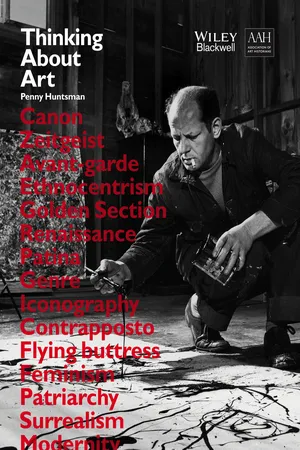
- English
- ePUB (mobile friendly)
- Available on iOS & Android
About this book
Consumerism
Pop art
Mechanisation
Baroque
Kitsch
Postmodern
Vanitas
Antiquity
Oeuvre
Chiaroscuro
Patron
Picture plane
Cubism
Ionic
Humanism
Critic
Abstracted
Screen print
Art market
Thinking About Art explores some of the most influential works of art and architecture in the world through the prism of themes, instead of chronology, to offer intriguing juxtapositions of art and history.
The book ranges across time and topics, from the Parthenon to the present day and from patronage to ethnicity, to reveal art history in new and varied lights.
With over 200 colour illustrations and a wealth of formal and contextual analysis, Thinking About Art is a companion guide for art lovers, students and the general reader. It is also the first A-level Art History textbook, written by a skilled and experienced teacher of art history, Penny Huntsman.
The book is accompanied by a companion website: www.wiley.com/go/thinkingaboutart.
Frequently asked questions
- Essential is ideal for learners and professionals who enjoy exploring a wide range of subjects. Access the Essential Library with 800,000+ trusted titles and best-sellers across business, personal growth, and the humanities. Includes unlimited reading time and Standard Read Aloud voice.
- Complete: Perfect for advanced learners and researchers needing full, unrestricted access. Unlock 1.4M+ books across hundreds of subjects, including academic and specialized titles. The Complete Plan also includes advanced features like Premium Read Aloud and Research Assistant.
Please note we cannot support devices running on iOS 13 and Android 7 or earlier. Learn more about using the app.
Information
Chapter 1
Genres and Subjects
Learning Outcomes
Chapter Map
History Genre
Portraiture
Genre
Landscape
Still Life
Subjects
Introduction
Table of contents
- Cover
- Image
- Title page
- Copyright
- Companion Website
- Acknowledgements
- Introduction
- Formal Analysis Toolbox
- Chapter 1 Genres and Subjects
- Chapter 2 Materials,Techniques and Processes
- Chapter 3 Form, Style and Function
- Chapter 4 Social and Historical Contexts
- Chapter 5 Patronage and the Social and Cultural Status of the Artist
- Chapter 6 Gender, Nationality and Ethnicity
- Glossary
- Index
- EULA